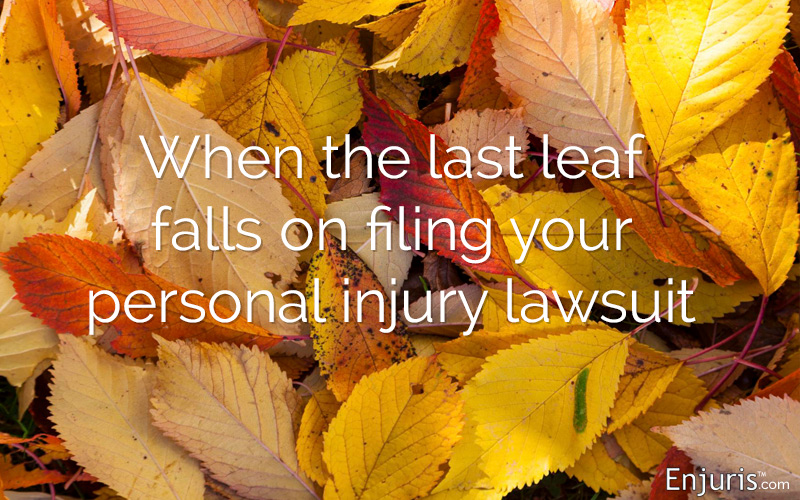
Don’t wait and miss the chance to file a lawsuit for your Montana personal injury case!
“Statute of limitations” is the legal term for the amount of time you have from when the injury happened to when you must file a lawsuit. If you wait too long, the court can refuse to hear your case.
Each state has its own statutes of limitations based on the type of injury. In general, the clock begins to run on the date of the accident or injury. In situations where you might not be immediately aware of an injury (like some kinds of medical malpractice, for instance), the time would begin at diagnosis or when a reasonable person should’ve become aware of the condition.
Why are there statutes of limitations?
A statute of limitations is established to preserve the integrity of a legal proceeding. A time limit helps ensure that evidence is intact and reliable through preservation of physical evidence or witness testimony.
It’s also a way that the court limits an injured person’s ability to continue to threaten a defendant indefinitely—or even blackmail them—if there wasn’t a time limit for filing a lawsuit.
Montana statutes of limitations
Below is a list of some common causes of civil action and lawsuits in Montana, along with their statute of limitations:
| Cause of Action | Time Limit | Statute |
|---|---|---|
| Action based on broken written contract or obligation | 8 years | Mont. Code Ann. § 27-2-202(1) |
| Action based on broken contract or obligation that is not written | 5 years | Mont. Code Ann. § 27-2-202(2) |
| Action for broken obligation or liability that’s not a contract, account, or promise and not written | 3 years | Mont. Code Ann. § 27-2-202(3) |
| Fraud or mistake | 2 years | Mont. Code Ann. § 27-2-203 |
| General and personal injury not based on a written instrument | 3 years | Mont. Code Ann. § 27-2-204(1) |
| Wrongful death by wrongful act or negligence | 3 years | Mont. Code Ann. § 27-2-204(2) |
| Wrongful death by homicide | 10 years | Mont. Code Ann. § 27-2-204(2) |
| Libel or slander | 2 years | Mont. Code Ann. § 27-2-204(3) |
| Assault and battery | 2 years | Mont. Code Ann. § 27-2-204(3) |
| False imprisonment | 2 years | Mont. Code Ann. § 27-2-204(3) |
| Seduction | 2 years | Mont. Code Ann. § 27-2-204(3) |
| Medical malpractice | 3 years (effective July 1, 2019) |
Mont. Code Ann. § 27-2-205 |
| Legal malpractice | 3 years | Mont. Code Ann. § 27-2-206 |
| Theft of, injury to, or trespass on property | 2 years | Mont. Code Ann. § 27-2-207 |
What if my lawsuit includes more than one claim?
Your lawsuit might include two separate causes of action that have different statutes of limitations.
For example, let’s say you’re filing a personal injury lawsuit for a car crash that happened 9 months ago. The statute of limitations on your physical injuries (medical costs, lost wages, and other expenses) is 3 years based on the law for “general and personal injury not based on a written instrument.”
However, perhaps you also want to include the damage to your car that happened in the same accident. Vehicle damage is under “theft of, injury to, or trespass on property,” which has a 2-year statute of limitations. You’ll need to file your lawsuit within that 2-year limit in order to make claims for both your property loss and the physical injury.
Exceptions to Montana statutes of limitations
There are certain special circumstances that extend a Montana statute of limitations, but these are rare.
A few of the possible reasons why a statute of limitations could be extended in Montana include:
- Age or mental capacity. If the person who experienced the loss was under 18 years old at the time of the loss, they have until 2 years after their 18th birthday to file a claim. If, at the time of loss, the person had a mental condition that required them to be institutionalized, they would have 2 years from the time they were declared mentally competent (but it cannot be more than 5 years from the date of loss).
- Death. If someone who’s entitled to bring an action dies within the statute of limitations, the deceased person’s representative may file the claim up to 1 year after the original party’s death.
- Partial payment. When part of a debt has been paid and acknowledged in writing, it could cause the statute of limitations to re-start at the time of partial payment.
Montana medical malpractice statute of limitations
Medical malpractice is one of those types of cases that is often so complex that it has its own rules.
The statute of limitations for Montana medical malpractice case is 3 years from the date of injury. This date changed from 2 years prior to July 1, 2019.
As in other types of personal injury cases, the clock begins to run on the date of injury or on the date that you should have known that the condition existed. This is also true for medical malpractice, except that you can’t file a lawsuit more than 5 years after the medical error was made.
There is an exception, though. If the defendant (i.e. the medical provider) knew or should’ve known that an error occurred but didn’t disclose it to the injured patient, the 5-year deadline doesn’t apply. If that happens, the statute of limitations stops running.
Don’t miss the chance to file your lawsuit
If you were injured because of someone else’s negligence, you deserve compensation for your expenses, and maybe for pain and suffering. Don’t miss out on the recovery you deserve because you waited too long to find out if you have a case. It’s hard to make the call to a personal injury lawyer—you might be nervous about the process, hesitant to share personal information, wondering if your case is worth pursuing, or maybe you’re not sure how much a lawsuit will cost. Many personal injury law firms offer an initial consultation at no cost.
Don’t let those concerns stop you from making the call. A personal injury lawyer will advise you about whether you have a case and what are the steps in the legal process. But, do it today. It’s never too soon to start working with an attorney after an accident or injury. Even if your insurance company is still involved in a claim, a personal injury attorney is there to represent your interests and be your advocate.
How do you find a Montana personal injury lawyer?
For starters, try asking friends and family if they have a referral. If not, the Enjuris personal injury law firm directory can direct you to a Montana injury lawyer who meets your needs. Find an attorney today who can help you recover what you deserve.
 Your First Meeting with an Attorney
Your First Meeting with an Attorney
A worksheet to prepare for your first meeting with a personal injury attorney – what to bring, what they'll ask
Download in PDF format![]()
 Personal Injury Attorney Interview Sheet
Personal Injury Attorney Interview Sheet
Worksheet with questions to ask a personal injury attorney to help determine if he or she will be a good fit for your case
Download in PDF format![]()
See our guide Choosing a personal injury attorney.
